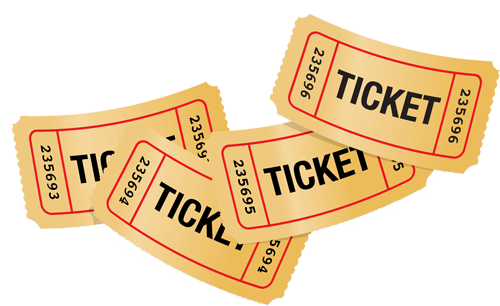 Here’s the Ticket!
Here’s the Ticket!
Reason #1: We make a lot of money using actual tickets, especially with merchandise dispensing machines. Take a look below at the Top 10 Games for WE 8-1-14 and focus on Rank #5 and #9. With eight of the ‘big expensive games’ in the Top 10, how can it be that two ‘little unknowns’ can compete? The only explanation possible is to admit that ‘it’s the tickets, stupid.’ In all of our game locations that have debit card systems, we give the customer the option of choosing ticketless or tickets. The majority still choose tickets. Some of our consulting clients have chosen to go ticketless. Here is what they are missing out on:
Top 10 Games out of 86 Games for WE 8-1-14 at Test Location #1
| 1 | Monster Drop Extreme |
| 2 | Wizard of Oz 6 Player |
| 3 | Big Bass Wheel #2 |
| 4 | Big Bass Wheel #1 |
| 5 | Ticket Candy Crane |
| 6 | Ticket Monster |
| 7 | Mega Stacker |
| 8 | Whack N Win |
| 9 | Knock it Off Rotary 4 Player |
| 10 | Color Match |
The revenues of the Ticket Candy Crane and Knock of Off Rotary tell the story:
- Ticket Candy Crane – $2854 with 25% ticket win. $1/play
- Knock It Off Rotary – $2294 with 23% ticket win. 50 cents/play
THE FOLLOWING WEEK KNOCK IT OFF MOVED UP TO #8 AND TICKET CANDY CRANE MOVED DOWN TO #7. This is absolutely amazing!!!!!
 The Ticket Candy Crane has been ranking in the Top 10 for the past several months and has been featured in previous TRR issues #22 and #23 . The Knock It Off has historically ranked between #40-#50 using round dishes with ticket vouchers inside for prizes. When the ticket vouchers were initially used as prizes 10 years ago, the KIO was a top earner but has fallen off over the years. If you want to increase revenue in a game that has coupons or ticket vouchers, like Knock it Off, replacing them with real tickets and increasing the hit frequency is the way to go. We learned this from experimenting with the Ticket Candy Crane (the smallest game in the FEC). We have found this to be true in most games using other means to represent real tickets. The KIO is another example of how tickets have the advantage over ticketless.
The Ticket Candy Crane has been ranking in the Top 10 for the past several months and has been featured in previous TRR issues #22 and #23 . The Knock It Off has historically ranked between #40-#50 using round dishes with ticket vouchers inside for prizes. When the ticket vouchers were initially used as prizes 10 years ago, the KIO was a top earner but has fallen off over the years. If you want to increase revenue in a game that has coupons or ticket vouchers, like Knock it Off, replacing them with real tickets and increasing the hit frequency is the way to go. We learned this from experimenting with the Ticket Candy Crane (the smallest game in the FEC). We have found this to be true in most games using other means to represent real tickets. The KIO is another example of how tickets have the advantage over ticketless.
 The KIO playfield is initially filled with 40 formations of ticket circles of 150 tickets each, 2 formations of 500 ticket circles, and one 1000 ticket dish as a major prize. Our ticket value is ¾ cent. The key here is to maintain a high hit frequency (# wins divided by # plays) and establish a goal of 25% ticket win %. Our current hit frequency is 1:10. A sign is helpful to encourage the winners to bring the won ticket circles to the Redemption Prize Center rather than take them apart and feed the tickets into the Ticket Centers. This will make it easier for staff to replace the ticket bundles won back onto the playfield to not only keep it full and looking enticing, but to maintain the 25% ticket win %. It does take some time and effort to keep making up replacement ticket bundles. Note that as the number of circles on the playfield decreases, the slightly more difficult it is for the players to win. The players know this and you want to keep the game looking attractive.
The KIO playfield is initially filled with 40 formations of ticket circles of 150 tickets each, 2 formations of 500 ticket circles, and one 1000 ticket dish as a major prize. Our ticket value is ¾ cent. The key here is to maintain a high hit frequency (# wins divided by # plays) and establish a goal of 25% ticket win %. Our current hit frequency is 1:10. A sign is helpful to encourage the winners to bring the won ticket circles to the Redemption Prize Center rather than take them apart and feed the tickets into the Ticket Centers. This will make it easier for staff to replace the ticket bundles won back onto the playfield to not only keep it full and looking enticing, but to maintain the 25% ticket win %. It does take some time and effort to keep making up replacement ticket bundles. Note that as the number of circles on the playfield decreases, the slightly more difficult it is for the players to win. The players know this and you want to keep the game looking attractive.
Another advantage of using a 4 player rotary is that 2, 3, or 4 players can work as a team to time their pushes to give one player an advantage of knocking the ticket bundle off the playfield-especially going for the 1000 ticket dish.
We will keep experimenting with different ticket formations and numbers of tickets to keep the customers interested. Every rotary model is different so what works for us may not work for you, but at least you now have the concept. Also note that the wholesale prize values we are using are $1.13 for 150 tickets, $3.75 for 500 tickets, and $7.50 for 1000 tickets, well under the maximum prize limits for all but 2 states.
(Thanks to Edwin Rodrigez, Alpha-Omega Super Tech, for helping make this concept work and for information provided)
Games are getting bigger and more expensive. Have you noticed?
Go back and take another look at the Top 10 Games. Yes, 8 of the 10 are the large footprint and taller games that come with the big price tags. Yes, these games attract players and make the most money because the players will play them at higher price/play costs of $1 or $2. Yes, this is a trend and TRR has debated if ‘bigger is better’ but there is more to the story.
What This Could Mean
One of the major game manufacturers pointed out to me that a game that we were testing was doing OK but not great and his next effort is aimed at making the cabinet and graphics larger. I asked why do that when we can work on improving the game to make it more challenging and perhaps have a winner? Here is what he told me:
In today’s market, a good regular sized game in a small cabinet can only sell a small number of games, perhaps several hundred at, say, $5000. If the game is made 2 feet taller, we can sell it for $7000. If we then can expand the footprint and make a very big game, we can sell it for $9000 plus. The larger we make the game the more profit we make. The more a customer pays for a game, the higher the price/play can be charged and the more money the game makes. The FECs are buying the higher priced games even more than they are buying the smaller sized games. The larger games are also an attraction and get a lot of attention. The game operators are not buying the larger footprint big expensive games (there is not enough space) but they also aren’t buying the less expensive regular size games either (they do not buy many new games any more). To be on the safe side, we (the manufacturer) are better off making the games bigger and selling less of them!
This reasoning seems to make sense when looking at it on a small scale. It can create a bubble that will surely burst. A large majority of FECs can only absorb a finite number of large footprint games. I have noticed that over the past 5 years, the number of games in our FEC facilities and client facilities has decreased by almost 10% just due to the games getting larger. And yes, these larger games are priced at $1/play and $2/play as are many of our merchandise dispensing games. We have gotten to the point where our players are spending their per capita rate faster and it is becoming more difficult to provide them with value for their money and time invested. To compensate we have to discount more and lower the price/play on other games so we have enough games at 25 cents/play and 50 cents/play to balance out.
To poke holes in the manufacturer’s reasoning to make larger more expensive games, was Reason #2 for us attempting to use tickets as prizes in small and regular size games and see if the revenues can match that of the ‘big boys.’ If we can accomplish that without spending any additional money, I believe the results are we do not have to just keep buying the larger games and end up with too many larger games. We all know that the outcome of that could be that we are forced to add more extremely large games. And a final statistic-we need to keep generating revenues from the games in the middle of the game space as the big boys need to be placed along the walls (in order not to block lines of sight throughout the game space).
That is why I spend a lot of time looking for new technologies that can be adapted to regular size games and lower height games. I hope to see more of you searching with me.



